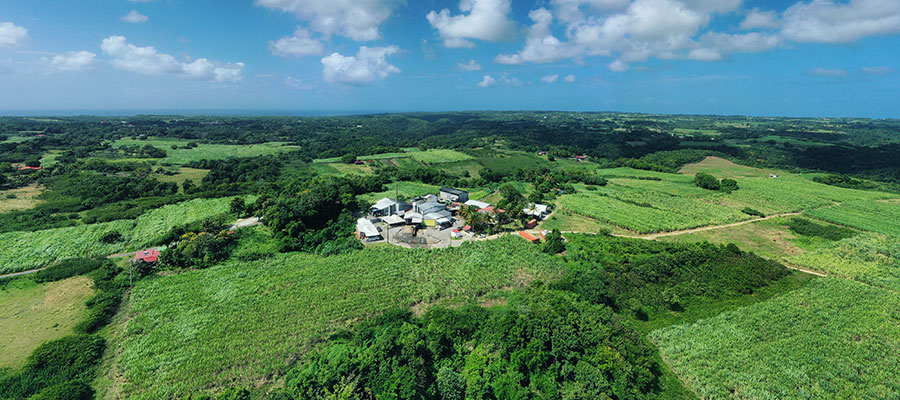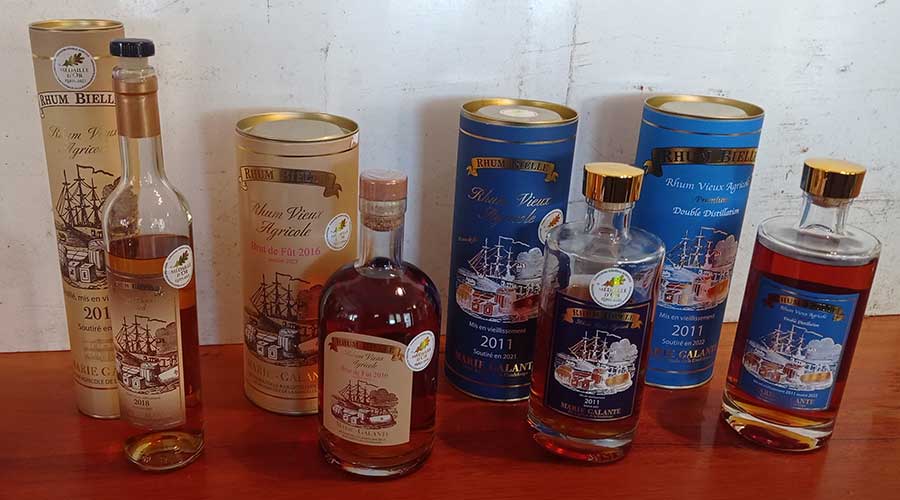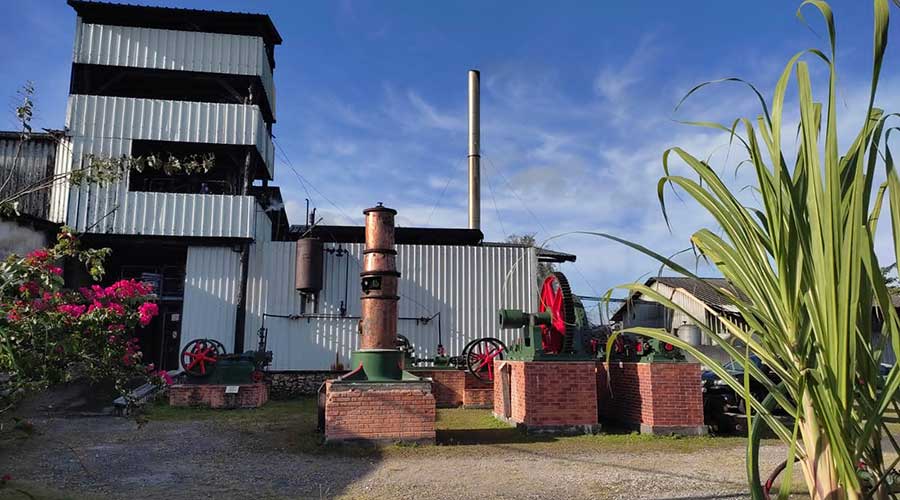The family distillery continues to amaze with its vintage rums, monovarietals, bruts de fûts, and its propensity to use sailing to transport its jewels across the planet…
Bielle’s origins can be traced back to 1769, when the eponymous family owned cane lands around Grand-Bourg. Later, in 1826, a sugar mill was set up on the estate, before an agricultural rum distillery was established in the early 20th century.
The distillery seems to have ceased operating for a few years, before being bought out in 1955 by Paul Rameaux, who refurbished it and relaunched rum production in 1958. In 1975, Dominique Thiéry, his grand-nephew, took over the reins. “Today, Bielle is the only 100% family-owned distillery on Marie-Galante, with me holding 70% and my nephew Jérôme 30%. As I’m not a 100% owner, I started out with a 3-6-9 industrial lease.
This is my sixth,” says Dominique Thiéry. But let’s go back to 1975 and the new era that Dominique Thiéry brought to Bielle. His beginnings were not easy, not to say complicated. The distillery had neither running water nor electricity. “To tell you the truth, I used to draw water from a pond adjacent to the distillery. Eventually, I was able to get water from a borehole, which meant that the quality of the rum remained constant,” recalls the man who, since 2020, has appointed his daughter Anne-Cécile General Manager of the distillery.
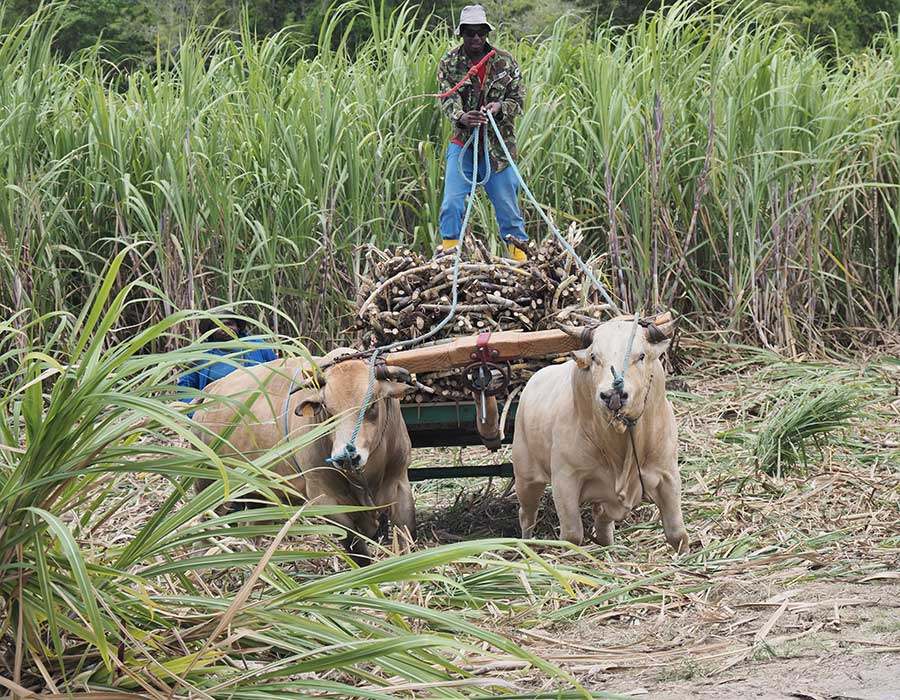
QUALITY STARTS IN THE FIELD
The quest for quality has always been the alpha and omega of the Bielle management team. As with all good rum stories, it all starts in the fields, where the sugar cane is grown. Marie-Galante lies on a limestone plateau free of volcanic rock, where sunshine is particularly abundant during the harvest period, while it rains sufficiently during the growing season, resulting in fine brix levels of between 23 and 26 at the last harvest.
The cane (transported by ox-cart) comes from some 150 of the island’s 1,300 growers. Bielle mainly asks for hand-cut cane that has been cut for less than 48 hours, as there are fewer bac- téries than on machine-cut cane,” explains cellar master Jacques Larrent. In 2023, we have decided to allocate an extra 15 euros per tonne of cane to our growers, on condition that the cane is delivered pretty and fresh.
We have to respect the hard work of the grower.” This respect is also reflected in Jérôme Thiéry’s competition for the best cane cutter. In 2022, for example, the winner, JC Jouial, cut 50 kilos in ten minutes!
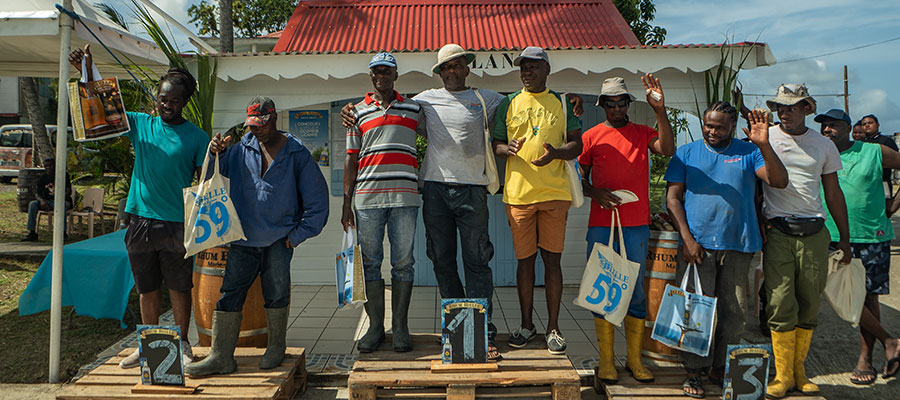
SWEET, FRUITY WHITE RUMS
Bielle’s white rums are made from canes that are well known to connoisseurs (red, black, blue), but Bielle has also launched a program to safeguard the island’s ancient varieties: cane grise, cane baltazia and cane genou cassé. Since 2015, the canne grise has been the subject of a monovarietal rum cuvée (gold medal in 2024), followed by the baltazia and the genou cassé (all three packaged in 50 cl).
Once the cane has been harvested and passed Aurélie’s quality control (no mean feat, given Aurélie’s sharp eye), they are passed through just two mills, with a single imbibition. The juice that comes out is therefore full of sugar and only slightly diluted. It is fermented in open vats (temperature around 28, 30°) with baker’s yeast for between 24 and 48 hours.
The vesou, which has an alcohol content of around 5%, is run under the supervision of master distiller Pierre Corbin, through three 16-tray “Savalle” columns, 3 of which are copper,” explains Jacques Larrent. This allows us to retain the aromas that disappear in columns with up to 40 trays. And we make sure never to push the rum above 75%. Once out of the column, the rum is left to rest for several months and reduced to 59% (the traditional degree for Marie-Galante rums), before being bottled for the local market.
“In total, we process 40 to 50 tonnes of cane a day and produce between 3,000 and 4,000 liters of white rum,” reveals Dominique Thiéry. Bielle’s particularly fruity white rums can be enjoyed as ti punches, neat, or with just a squeeze of lemon, so well-made are they. In particular, the Rhum blanc premium cuvée, 50 cl 59%, and of course the magnificent Canne grise!
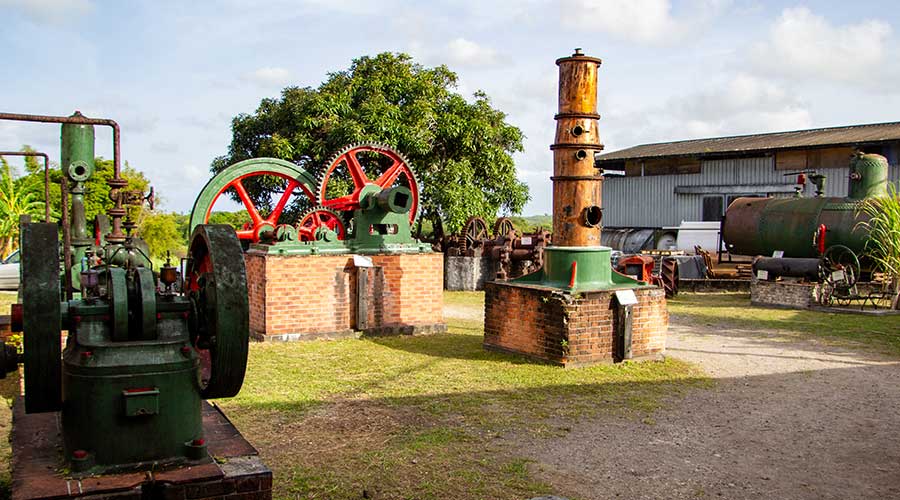
NO DILUTION IN MAINLAND FRANCE!
Rum destined for mainland France travels to Cognac by tanker, before being bottled on site. Jacques Larrent explains: “60% of the rum leaves Marie-Galante, and because of the journey, 59% arrives in mainland France, where it is bottled without reduction on the spot. We’ve heard people say that there’s a reduction on tap water in Cognac, but that’s not true.
What is true is that the rum is a little different because it has been brewed at sea in its tank. We know very well that the longer white rum is rested, the better it is. We have a 1,000 hectoliter tank on site, which we constantly replenish and which is almost always full. So the white rums marketed in mainland France in 2024 are in fact 2023s, and some 2022s! Now you’re talking!
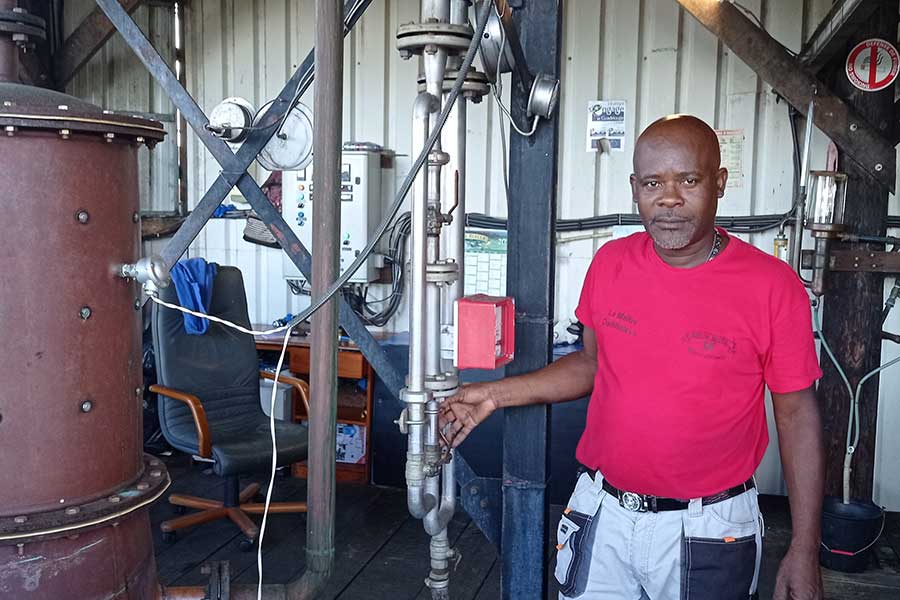
VINTAGE AGED RUMS
The constant quest for quality is also reflected in the range of aged rums. Not least thanks to the arrival of Jacques Larrent 13 years ago, following a career at Cognac Martell, where as production cellar manager, he oversaw no less than… 200,000 barrels! “Initially, I’d come to Marie-Galante on vacation, and as I’m a real enthusiast, I visited the distillers and met Dominique Thiéry.
We exchanged a few days a year,” he recounts. There was already this quest for quality in old rums, and when I became cellar master, all I had to do was push things further, notably with the release of the 1994 vintage, a very top-of-the-range rum sold at a very high price at the time.” And indeed, the proprietor is one of Guadeloupe’s forerunners when it comes to aging rums.
“I was one of the first producers to age rums in barrels I had bought in Trinidad with Roger Damoiseau (Hervé’s father, editor’s note). That was in 1994,” says Dominique Thiéry. I still have some, but I keep it for myself… or for people with fat bank accounts (laughs)”. And he was also one of the first to bet on vintages, whereas it was customary for old rums to be blends. Today, all the distillery’s aged rums feature their year of production on the label.
In the same vein, Bielle was one of the first distilleries in Guadeloupe to release brut de fût rums. Currently available as brut de fût are the 2020 Chambord (aged in oak barrels of the same name) and the 2016 Rhum vieux, gold medal winner in 2024. With an angel’s share of 8%, the rum undergoes accelerated ageing, taking half a barrel after 7 or 8 years.
THE BOURBON BARREL BRAND
Even amber rums receive special attention, where they are usually the poor cousins of the range. “There aren’t really any regulations governing the production of amber rums, so some people put wood and caramel in white rums and sell them unaged. It’s legal,” reveals Jacques Larrent. At Bielle, we’ve dedicated 200 barrels, registered with Customs, to the production of amber rum that has actually aged.” Bielle also prides itself on working to cask strength, meaning that no wood or caramel is added.
The casks used for aging are mainly ex-bourbon, but the rums can also spend time in new casks, cognac or white wine barrels, depending on the inspiration of Jacques Larrent, who also plays with the size of the grains and the toasting. “Wood is essential for rum to age, but I don’t like drinking wood juice! We produce elegant rums, without the astringency and tannin of wood”, warns the man who, by the end of 2024, will have 2,500 barrels under his care.
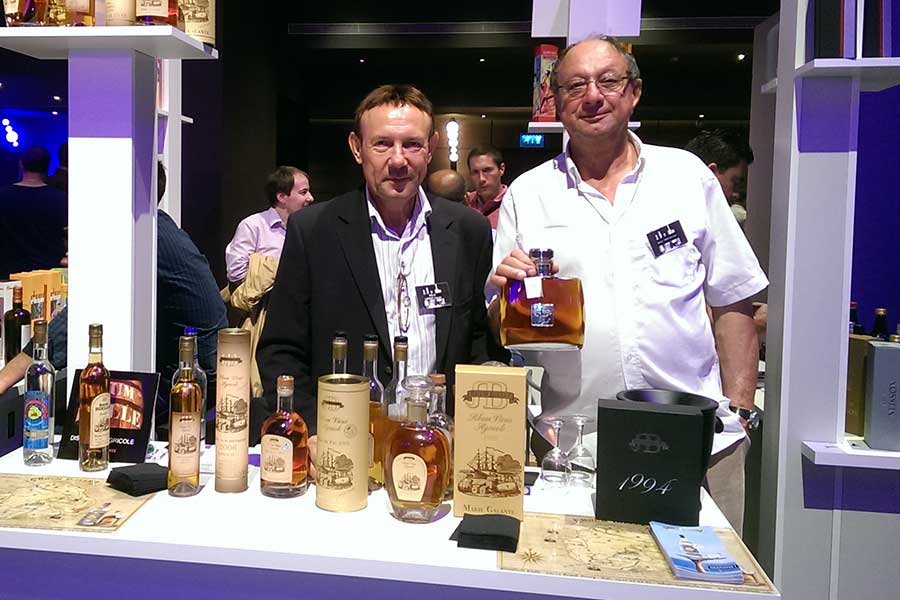
THE OLD MAN AND THE SEA
Dominique Thiéry was an environmentalist from an early age. It’s to avoid bringing dry materials (bottles, corks…) to Marie-Galante, that he opted for bulk transport of his white rum destined for mainland France. He is also committed to cutting cane by hand and transporting it by oxen. He is convinced that “the future of rum on Marie-Galante is organic”.
And he is also one of the first, if not the first, to have revived the idea of transporting aged rums by sail and dynamic ageing at sea. The first Bielle rum schooner crossing (with Fair Transport) having been carried out in 2016 in partnership with the Cavavin network. Since then, several vintages have made the trip to Brittany. Bielle even had its own boat, but it sank off the Pointe des Châteaux in 2020.
This sad event (58 mini-barrels were lost, but no one was injured) did not inoculate Dominique Thiéry. His next project is to take his rum barrels on a sailing boat, following in the footsteps of Ulysses in the Mediterranean. We can’t wait to taste the fruits of this odyssey.
MARIE-GALANTE, THE ISLAND OF CANE AND RUM
Marie-Galante was the first island in the Guadeloupe archipelago to be visited by a European, Christopher Columbus, on his second voyage in 1493. The island was previously occupied by the Huécoïdes and Arawaks. Located around 20 km south of the Basse-Terre and Grande-Terre coasts, and around 40 km from Dominica, Marie-Galante covers an area of 158 km2 and is home to just under 11,000 inhabitants.
It comprises three communes: Saint-Louis, Grand- Bourg and Capesterre-de-Marie-Galante. Since the arrival of the first French settlers in 1649, Marie-Galante has been, and continues to be, a cane island. It has been home to up to 100 settlements, most of which grew sugar cane and were powered by windmills. Hence its nickname, the island of 100 windmills.
Today, sugar cane is both the most widespread crop and a major source of income and employment. Marie-Galante has long been a sugar-producing island, and several factories were built in the 19th century, of which only the Grand-Anse factory remains today, owned by a private group and by the planters through the island’s SICA. It is also a distillery and still produces sugar, as well as traditional molasses rum.
But the island is now best known for its agricultural rum, a turnaround that began in the late 19th century. Today, only three agricultural rum distilleries remain in operation: Bellevue, Poisson (Père Labat) and Bielle.

